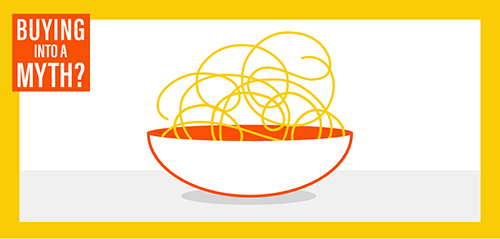BUYING INTO A MYTH?
Marketing Myth #6: The purchase funnel is still a thing
Wait, the purchase funnel isn’t a thing? How can that be? As marketers, we’ve long embraced the idea that we can guide buyers down a linear path to purchase, narrowing from awareness to consideration to action. But the truth is messier.
In assessing today’s buyer journey, it’s worth revisiting an eye-opening Google research project that ran 310,000 simulated purchase scenarios across 31 industry categories. It found that today’s purchase journey looks less like a funnel than a bowl of spaghetti.
How buyers really buy today
As Google discovered, a buyer’s path isn’t linear, or entirely rational. Instead, it’s a continuous loop of exploration and evaluation – of browsing and comparing products online, of surveying friends and influencers. The question, then, is how can marketers influence such a chaotic process where the buyer is clearly in control?
The messy middle
Buyers today toggle between exploring an open-ended set of choices and a smaller subset.
Google: today’s purchase decision model1
Moving buyers to action
Given the realities of today’s marketplace, it’s time to evolve our thinking about the customer journey. Instead of trying to guide buyers through a linear funnel, we need to inhabit the “messy middle,” always at the ready with the options, input and content that buyers need.
To get them off the fence, it’s also vital to tap into some irrational, but thoroughly predictable buying behavior. The key is understanding that consumers are hardwired to look for certain signs they’ve found a great product or deal. Behavioral research has revealed many of these cognitive biases, and smart marketers today are triggering them to nudge consumers to buy. Google looked at six of them.
Putting cognitive bias to work
In testing, social proof (for marketers who possess it) was usually the most powerful bias, followed by category heuristics, which proved especially decisive in financial services. But all six biases can be used by marketers to powerful effect.
How powerful? In its experiment, Google made marketing claims that triggered all six biases. When testing the effect of this on the purchase journey, Google found a vast majority of consumers were willing to switch from their first-choice brand to their second choice, from 72% for mobile network provider to 94% for car insurance. In most categories, a majority were even ready to shift from their first-choice brand to a totally made-up brand.
By leveraging your resources and buyers’ cognitive biases, you can increase the chances that customers choose you from that bowl of spaghetti.
Where should marketers go from here?
Should you pour resources into the same upper and lower funnel activities? While we continue to see the need for a strong brand presence upfront and a seamless experience at purchase, the action today is in the messy middle.
If you’re ready to rethink the way you engage consumers during the purchase journey, let’s talk ›
1 Google, “Decoding Decisions: The messy middle of purchase decisions,” 2020
Marketing Myth #1: Demand generation is king ›
Marketing Myth #2: Cutting marketing budgets is wise in a recession ›
Marketing Myth #3: Customer loyalty beats customer acquisition ›
Marketing Myth #4: Well-known brands don’t have awareness problems ›
Marketing Myth #5: B2B campaigns should be rational, not emotional ›
Marketing Myth #7: Marketing is secondary to sales in B2B ›
Marketing Myth #8: Repeating what works will keep on working ›
Marketing Myth #9: Data-driven is always better than people-driven ›




 See what they have to say
See what they have to say